The Open Weekender
by Bill
Paxton
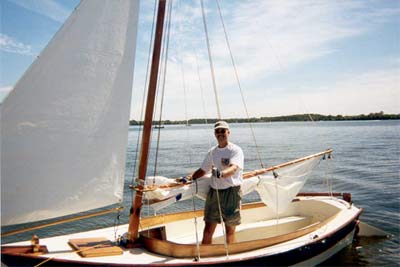
I’m still not sure what came over me during the long winter
of ‘98-’99, but suddenly I had this terrible itch
to build a sailboat. If you’ve ever been so inflicted then
you know it is not to be denied, so I set about to find some plans.
My criteria was simple:
- trailerable
- daysailer
- beautiful
- easy to build since I was a total novice.
It didn’t take long before I landed upon the Weekender
by Stevenson Projects.
I fell in love with her romantic lines, and her plans came with
a how-to-build video. The hook was set deep, and I ordered the
plans.
The Weekender is a wonderful boat as designed, but I just couldn’t
leave well-enough alone. I got looking at the plans and decided
the cockpit was too small for my bride and I. (We’re both
over 6’ tall.) Concurrently I discovered an ad in WoodenBoat
for the Haven
12 ½ . Something in my brain snapped, and
I decided to remove the cabin from the Weekender, run the seats
forward, and make her an open boat. There was some precedent for
this. Bob Butler, who had already built two Weekenders, built
a third Weekender as an open boat, and created my dreamboat.
Since the Weekender has no centerboard case (it has a keelson
that runs the length of the boat), and is flat bottomed, the flat
sole makes every inch of the layout usable.
If I had known anything about boat design, I would have been
worried that I was weakening the hull be removing the cabin and
its corresponding bulkhead. But ignorance was bliss, and I proceeded,
unencumbered by the thought process. As it turns out, the seats
added plenty of stiffness to the hull. I’ve since had her
out in serious chop, and she’s held together like a champ.
It turns out that the regular Weekender and my open version use
the same amount and type of plywood. The cockpit coaming is ¼”
marine ply, just like the plans specify for the cabin sides.
After seven months of building we named her Surprise and launched
her on June 5, 2000. The boat turned out to be a great daysailer.
She goes from trailer to water in about 15 minutes, unless curious
passersby want to know all about her. Raising the folding mast
is a snap since I can walk right up to the mast without having
to get on the deck. She comfortably sails four adults, giving
us plenty of room to sprawl in the 10’ cockpit. She is exactly
what I had hoped for.
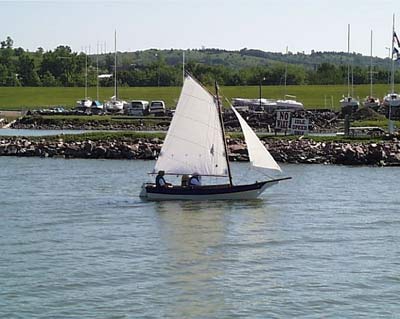
Although the elimination of the cabin was the most radical departure
from the plans there were other minor deviations, all designed
to make our sailing experience more enjoyable.
- I switched to a tiller instead of a wheel. The wheel is necessitated
by the relatively tight cockpit on the Weekender, but since
I had all the space I wanted, I went with a tiller which allows
me to shift my weight farther forward if I so choose.
- The seat hatches were moved from the vertical face of the
seats supports to the top.
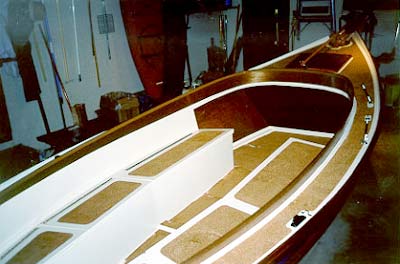
- Instead of attaching the mainsail to the mast with mast hoops,
I laced the sail to the mast. It saved me the trouble of making
hoops, and works just fine. (Last winter I sailed on a 76’
schooner out of Key West, and darned if her big sails weren’t
laced to the masts.)
- A common complaint among Weekender sailors is that the open
gaff jaws get hung up on the shrouds when the mainsail is let
out while running. In my book, not being able to haul in the
mainsail when you want to is a big problem. I solved it by making
the jaws longer and boxing in the open end.
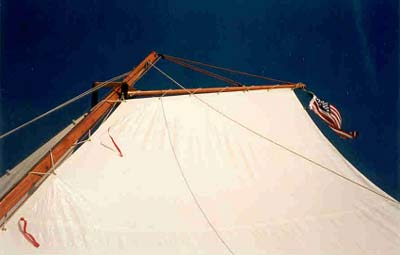
- The plans call for an uphaul and a downhaul for the rudder.
I only used the uphaul when the boat was on the trailer. In
the water, the wooden rudder floats naturally. My problem was
that when I was approaching a dock I had one hand on the tiller,
one on the main sheet, and needed a third hand to ease the rudder’s
downhaul so the rudder wouldn’t drag on the bottom. I
figured it was easier to re-rig the rudder than grow a third
arm. I used Jim Michalak’s plan to add weight to the rudder
so it would stay down by itself, and naturally rise with the
contour of the lake bottom. I ran the uphaul along the top of
the tiller so it’s handy when I need it.
- I wanted to make sure my boat wouldn’t sink if I managed
to flip it. With that in mind I put individual polyethylene
air chambers (sealed, empty milk jugs) behind the seat backs.
They are secured in place so they never rattle around. I also
made the forward bulkhead solid instead of making large cutouts
in it as the plans describe. This creates a large air cavity
in the nose.
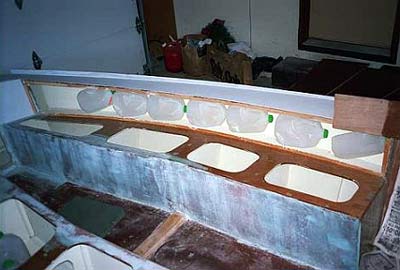
If you want to see more, check out my
building and sailing photos. There you’ll also
find pictures of the beautiful Weekender Julie K, built by Dave
Richards of Rochester, MN. |

